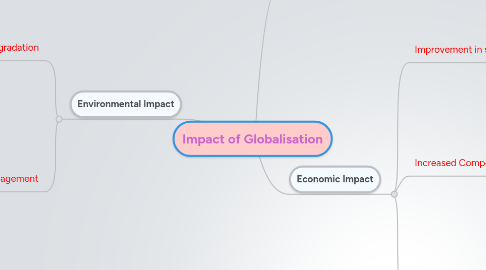
1. Environmental Impact
1.1. Environmental degradation
1.1.1. Deforestation and related problems
1.1.1.1. - Rainforests in many countries have been cut down - make way for industry, housing, agriculture and transportation development - Govt allow rapid deforestation because can generate more revenue faster.
1.1.1.2. - Deforestation in INDONESIA result in environmental problems like soil erosion, loss of flora and fauna, increased flooding, haze - haze caused by burning of forest which is fastest and easiest way to clear land. - haze cause countries in region to suffer heavy losses in terms of tourism.
1.1.1.3. -Three Gorges Project in CHINA caused erosion, loss of flora and fauna, water pollution
1.1.2. Global Warming
1.1.2.1. - Movement of goods through aeroplanes and ships produce a large amount of greenhouse gases. - Factories and modes of transport emit a large quantity of fumes into atmosphere everyday. - Presence of these gases lead to increse in average global temperature.
1.2. Environmental management
1.2.1. - Increase in environmental degradation led to increase awareness of environment management - sustainable development is key to further growth. - Environment well-preserved, future generations use resources to generate income, continue high SOL
1.2.2. -Amount of energy needed by globalising world is enormous - Growth of energy comes from countries that are rapidly developing like china & India as they embark on large-scale industrialisation.
1.2.3. - Need to sustain power by conservation - Conservation alone unable to meet challenge of supplying vast quantities of energy needed for development - alternative sources: wind, solar and geothermal power provide some energy that account for small proportions of world energy needs - problems using such alternative sources like building a dam across fast flowing water is environmentally hazardous and expensive
2. Economic Impact
2.1. Improvement in standard of living
2.1.1. - Globalising countries enjoy increase in income levels - Earn more revenue with trade and by opening doors to FI - Govt make use of revenue on education, health, defence, housing, transportation - Ppl thus enjoy higher SOL - With free trade, consumers buy variety of goods besides local goods - eg. supermarket local vs foreign brands - Increase in lifestyle, increase in QOL
2.2. Increased Competition among nations
2.2.1. Investment and Market
2.2.1.1. - TNCs seek locations with low production cost - Govt compete to attract TNCs to invest in their countries - eg. China: They open doors to FI and FI chose to set up production facilities there because of low production cost. Many cities thus become developed because they have industrial infrastructure, thus becoming attractive to FI. They pose as a strong challenge to other countries - Competition for investment and market is intense. - Countries offering incentives to FI are more attractive - Competition for investments and markets lead to further growth in country and infrastructure more developed - Developing countries difficult to attract FI because of poor infrastructure and political stability - thus trap in a poverty cycle
2.2.2. Talent
2.2.2.1. - With globalisation, people are able to travel from country to country - in search for employment or leisure activities - highly skilled ppl on high demand - Globalisation is a opportunity to find employment in another place. - advanced countries with stable/shrinking population search for foreign talent - emerging economies try to attract back the brightest
2.3. Widening Income Gap between rich and poor
2.3.1. - Result in rapid development in countries - and spread of poverty over many countries - Developing countries have increase income growth as they own manufacturing companies - TNCs draw skilled people from poor areas and relocate them in beneficial places - International trade generate much revenue for them - Developing countries face trade restrictions with DCs - Lowly skilled workers incapable of producing better quality goods that can be of high price - TNCs employ labour intensive and low value added production in poorer nations - Factory workers face poor living conditions -Widen income gap in DCs: rich become richer, poor and lowly skilled face retrenchment. - may lead to social problems
3. Social Impact
3.1. Increase awareness of foreign culture
3.1.1. - Ppl more aware of different culture - learn about history, culture, WOL of ppl across the globe - through travelling, surfing Internet or watching foreign movies at home
3.2. Loss of local culture
3.2.1. - Global brands like Starbucks dominate consumer market in developing countries. - They have many identical outlets to standardize their method of operation - created homogenous culture across the globe
3.2.2. - Spread of pop culture - Negative influence to youths as they lose interest in local culture - Ppl uncomfortable with advancement in foreign culture - think these countries force beliefs, cultures and languages upon the world.
